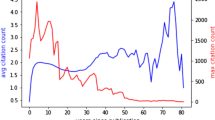Abstract
A viewpoint is given, according to which, addivitity may be defined only at the intuition level and quantitative latent variables are “origin additive”. The proposed solution to the non-additivity problem consists in restricting quantitative indicator scales by the so-called “natural”, in particular, open scales.
Similar content being viewed by others
Notes and references
S. D. HAITUN, The stationary scientometric distributions. Part I. Different approximations,Scientometrics, 4 (1982) 5; Part II. Non-Gaussian nature of scientific activities, Ibid.,Scientometrics, 4 (1982) 89; Part III. Role of the Zipf distribution, Ibid.Scientometrics, 4 (1982), 181.
See, for example: S. S. STEVENS, Mathematics, measurement and psychophysics, in:Handbook of Experimental Psychology, S. S. STEVENS (Ed.), Wiley, N. Y., 1951, p. 1–49; M REUCHLIN, Measurement in psychology, in:Experimental Psychology. Its Scope and Method, P. FRAISSE, J. PIAGET (Eds), Basic Books, N. Y., 1968, p. 193–237; A. G. AGANBEGIAN, B. N. SHUBKIN, Sotsialniye issledovaniya i kolichestvennye metody (Social investigations and quantitative methods), in:Kolichestvenniye metody v sotsiologii (Quantitative Methods in Sociology), Nauka, Moskva, 1966, p. 5–32; J. PFANZAGL,Theory of Measurement. With cooperation of V. BAUMANN, H. HUBER, 2nd revised ed., Physica-Verlag, Würzburg-Wien, 1971; G. V. OSIPOV, E. P. ANDREEV,Metody izmereniya v sotsiologii (Measurement Methods in Sociology), Nauka, Moskva, 1977.
See, for example: S. S. STEVENSop. cit. note 2.
“as a matter of fact, most of the scales used widely and effectively by psychologists are ordinal scales” (S. S. STEVENS,op. cit., note 2); “All sociological and social psychological measurements are yet taken on the nominal and ordinal scales... and only timid steps are being taken to make use of more developed scales” (G. V. OSIPOV, E. P. ANDREEV, op. cit., note 2,Metody izmereniya v sotsiologii (Measurement Methods in Sociology), Nauka, Moskva, 1977, p. 65).
See, for example: E. LANDAU,Grundlagen der Analysis, Berlin, 1930; S. FEFERMAN,The Number Systems. Foundations of Algebra and Analysis, Addison-Wesley, Pali Alto-London, 1963.
In one of the best Soviet handbooks onElementary Mathematics byVygodskii (M. Ya. VYGODSKII,Spravochnik po elementarnoi matematike, Nauka, Moskva, 1965), which has seen more than 20 editions and passed through the “censorship” of prominent Soviet mathematicians, for example, is said: “Addition. The concept of addition arises from such simple facts that it does not need any definition and cannot be defined formally” (p. 67). In the footnote to this definition is written: “often” “definitions” are given such as: “addition is an operation with which several numbers are combined into one”, or “an operation performed to find how many units are contained in several numbers taken together”. But, if one does not know what “addition” means, then one would not know what “combine together” means. Thus, similar “definitions” are only a game of words” (ibid.) (M. Ya. VpygodskiiSpravochnik po elementarnoi matematike, Nauka, Moskva, 1965)
See, for example: B. G. MIRKIN,Analiz kachestvennykh priznakov i struktur (Analysis of Qualitative Items and Structures), Statistika, Moskva, 1980.
The existence of a subjective component in the nature of a latent variable has been realized by some researchers.Green, for example, talks about the psychological concept of attitude, discussed by him,as abstraction (B. F. GREEN. Attitude measurement, in:Handbook of Social Psychology, GARDNER, LINDZEY (Eds), Vol. 1, Addison-Wesley, Cambridge, 1954.
See, for example: P. SUPPES, J. ZINNES: Basic measurement theory, in:Handbook of Mathematical Psychology, Vol. 1, Wiley, N. Y., 1963; C. H. COOMBS, R. M. DAVIS, A. TVERSKY.Mathematical Psychology. An Elementary Introduction, Englwood Cliffs, New Jersey, 1970.
See, for example: G. A. KORN, T. M. KORN.Mathematical Handbook for Scientists and Engineers, McGraw Hill, N. Y., 1968.
G. A. MILLER, The magical number seven, plus or minus two. Some limits on our capacity for processing information,Psychological Review, 63 (1956) 81.
See, for example: S. D. HAITUN,op. cit., note 1; S. D. HAITUN,Naukometriya: sostoyanie i perspektivy (Sientometrics: State and Prospects), Nauka, Moskva, 1983.
J. S. COLEMAN,Introduction to Mathematical Sociology, Free press of Glencoe, N. Y., 1964.
See: S. D. HAITUN. The “rank-distortion” effect and non-Gaussian nature of scientific activities,Scientometrics, 5 (1983) 375.
Author information
Authors and Affiliations
Rights and permissions
About this article
Cite this article
Haitun, S.D. Problems of quantitative analysis of scientific activities: The non-additivity of data. Part I. Scientometrics 10, 3–16 (1986). https://doi.org/10.1007/BF02016856
Received:
Revised:
Issue Date:
DOI: https://doi.org/10.1007/BF02016856




